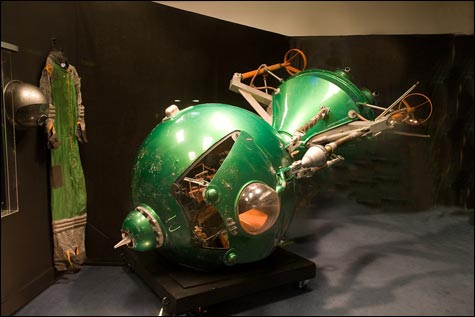Living the dream
By IAN PAIGE | February 11, 2009

“FALLEN SPACESHIP” Installation by Randy Regier. |
Randy Regier, 44, received his MFA from the Maine College of Art and is now an instructor there and at Bowdoin College. He is the recipient of a Maine Arts Commission 2009 Fellowship and is currently exhibiting two installations. "Lost & Found: Anna Isaak and the Cabot Mill" utilizes the open space of the Coleman Burke Gallery in Brunswick in an ingenious manner that creates a hidden world of fictive detail to light up the viewer's curiosity. "Now Your Spacecraft Will Be Your Peace" features an elaborate display of bygone space-age ephemera surrounding an almost-plausible spaceship in the window of the new 511 Congress Street gallery as part of SPACE Gallery's "Windowkammers" exhibition. The Portland Phoenix caught up with him to find out how it all began.Let's begin with an explanation of your American Dream Technical Institute.
The ADTI is something I came to as a way of casting a broad net over all the things that fascinate me. Any legitimate institution needs a mission to justify their existence. I figure if I'm going to keep playing around in this world of institutional critique, this is fertile ground playing all the roles: curator, preparator, archaeologist, director. I've done this most of my life. Burying things as a kid and digging them back up. Fictive worlds. It's a fairly recent moniker, but it's something I've done for 44 years.
Can you use one of your current works as an example of the ADTI process?
I want to make something clear. When I speak of art. I don't think of it as an object, painting, sculpture. That's not how I conceive of it. For me, Art is a verb, an action. If you look up the word "play" in the OED, my favorite word definition is "to move or operate freely within a bounded space as machine parts do". All spaces are bounded spaces, the room we're in, the conversation, relationships, genders. We are never free to do anything and everything we choose to do. To find a way to move and operate freely within that is the challenge that confronts us all.
So the ADTI is the biggest space I've ever found to play in. I can run like hell like a dog without fences. The boundaries are there but it's a vast space. It's as big as time. I go back to 1949 and build a race car and come back to 2009 and discover it. I'm aware of the difference between the fabricated race car and the little artifacts in the cedar chest which, except for one, are all found objects. Ebay, friends, antique stores. Very carefully, specifically chosen but there are items in there that I serendipitously found and it gave me goosebumps — I didn't know they existed and they came to me — they might mean more to me than the car I built because of that.
 Topics
Topics:
Museum And Gallery
, Science and Technology, Technology, Bowdoin College, More  , Science and Technology, Technology, Bowdoin College, Bowdoin College, Space Technology, Maine College of Art, Maine College of Art, Maine Arts Commission, Randy Regier, Randy Regier, Less
, Science and Technology, Technology, Bowdoin College, Bowdoin College, Space Technology, Maine College of Art, Maine College of Art, Maine Arts Commission, Randy Regier, Randy Regier, Less 